Australian Commercial Law Assignment: Contract Analysis and Breach
VerifiedAdded on 2021/05/27
|13
|3287
|48
Homework Assignment
AI Summary
This assignment delves into Australian commercial law, examining a constitution's framework for a tribe, and analyzing a contract dispute between Barry and Angela. Part A explores the implementation of a three-part legal system and secondary rules, drawing parallels to the Australian constitution. Part B investigates potential vitiating factors, particularly misrepresentation, in a business purchase scenario, citing case law like Esso Petroleum v Mardon and Derry v Peek. The analysis determines whether Barry can void the contract due to false statements about the business's turnover and competitors. Part C considers potential breach of contract if Barry does not exit the contract, focusing on implied terms, and the Sale of Goods Act 1954 (Cth) regarding the provided van and machinery. The assignment applies legal principles to real-world situations, providing a comprehensive analysis of contract law concepts, including misrepresentation and breach of contract.
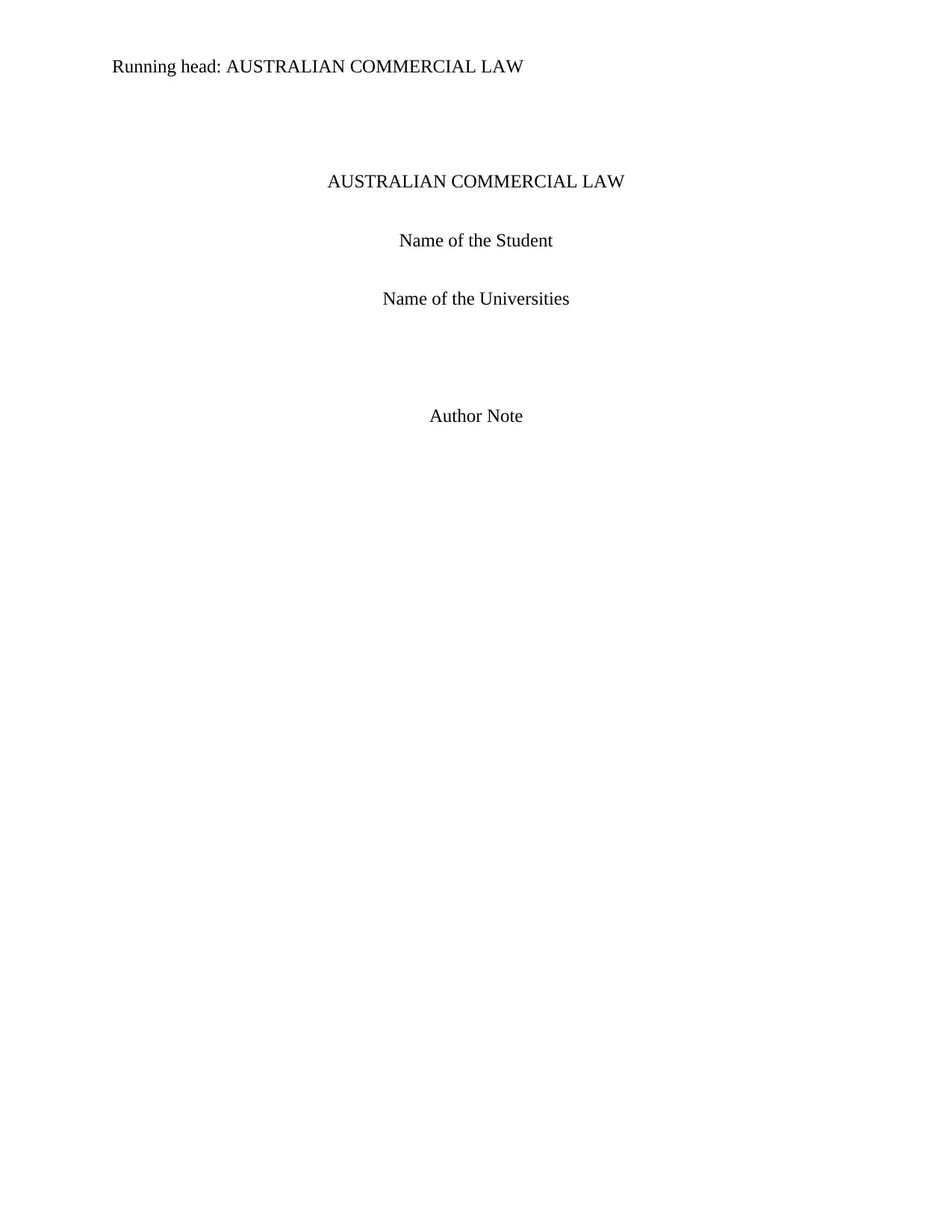
Running head: AUSTRALIAN COMMERCIAL LAW
AUSTRALIAN COMMERCIAL LAW
Name of the Student
Name of the Universities
Author Note
AUSTRALIAN COMMERCIAL LAW
Name of the Student
Name of the Universities
Author Note
Paraphrase This Document
Need a fresh take? Get an instant paraphrase of this document with our AI Paraphraser
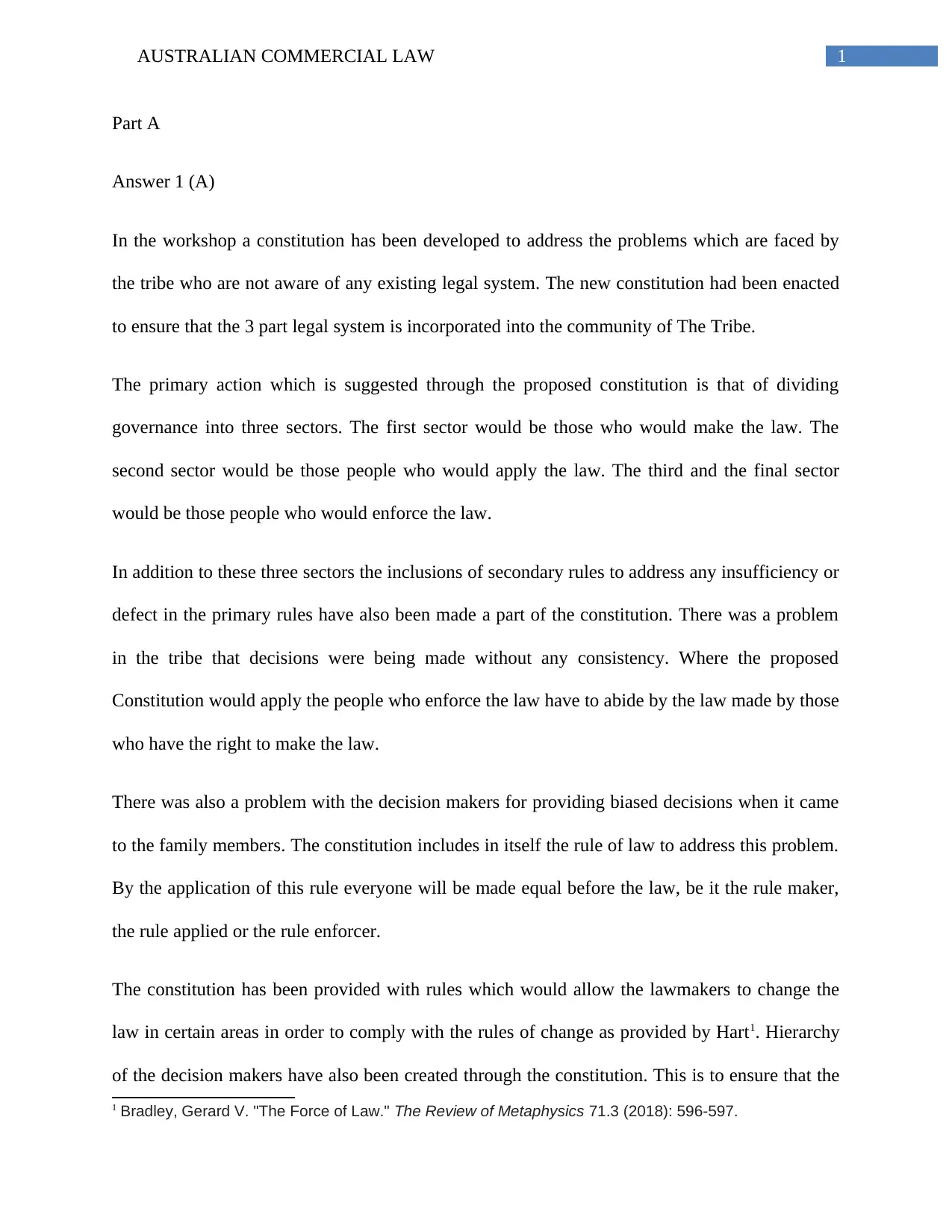
1AUSTRALIAN COMMERCIAL LAW
Part A
Answer 1 (A)
In the workshop a constitution has been developed to address the problems which are faced by
the tribe who are not aware of any existing legal system. The new constitution had been enacted
to ensure that the 3 part legal system is incorporated into the community of The Tribe.
The primary action which is suggested through the proposed constitution is that of dividing
governance into three sectors. The first sector would be those who would make the law. The
second sector would be those people who would apply the law. The third and the final sector
would be those people who would enforce the law.
In addition to these three sectors the inclusions of secondary rules to address any insufficiency or
defect in the primary rules have also been made a part of the constitution. There was a problem
in the tribe that decisions were being made without any consistency. Where the proposed
Constitution would apply the people who enforce the law have to abide by the law made by those
who have the right to make the law.
There was also a problem with the decision makers for providing biased decisions when it came
to the family members. The constitution includes in itself the rule of law to address this problem.
By the application of this rule everyone will be made equal before the law, be it the rule maker,
the rule applied or the rule enforcer.
The constitution has been provided with rules which would allow the lawmakers to change the
law in certain areas in order to comply with the rules of change as provided by Hart1. Hierarchy
of the decision makers have also been created through the constitution. This is to ensure that the
1 Bradley, Gerard V. "The Force of Law." The Review of Metaphysics 71.3 (2018): 596-597.
Part A
Answer 1 (A)
In the workshop a constitution has been developed to address the problems which are faced by
the tribe who are not aware of any existing legal system. The new constitution had been enacted
to ensure that the 3 part legal system is incorporated into the community of The Tribe.
The primary action which is suggested through the proposed constitution is that of dividing
governance into three sectors. The first sector would be those who would make the law. The
second sector would be those people who would apply the law. The third and the final sector
would be those people who would enforce the law.
In addition to these three sectors the inclusions of secondary rules to address any insufficiency or
defect in the primary rules have also been made a part of the constitution. There was a problem
in the tribe that decisions were being made without any consistency. Where the proposed
Constitution would apply the people who enforce the law have to abide by the law made by those
who have the right to make the law.
There was also a problem with the decision makers for providing biased decisions when it came
to the family members. The constitution includes in itself the rule of law to address this problem.
By the application of this rule everyone will be made equal before the law, be it the rule maker,
the rule applied or the rule enforcer.
The constitution has been provided with rules which would allow the lawmakers to change the
law in certain areas in order to comply with the rules of change as provided by Hart1. Hierarchy
of the decision makers have also been created through the constitution. This is to ensure that the
1 Bradley, Gerard V. "The Force of Law." The Review of Metaphysics 71.3 (2018): 596-597.
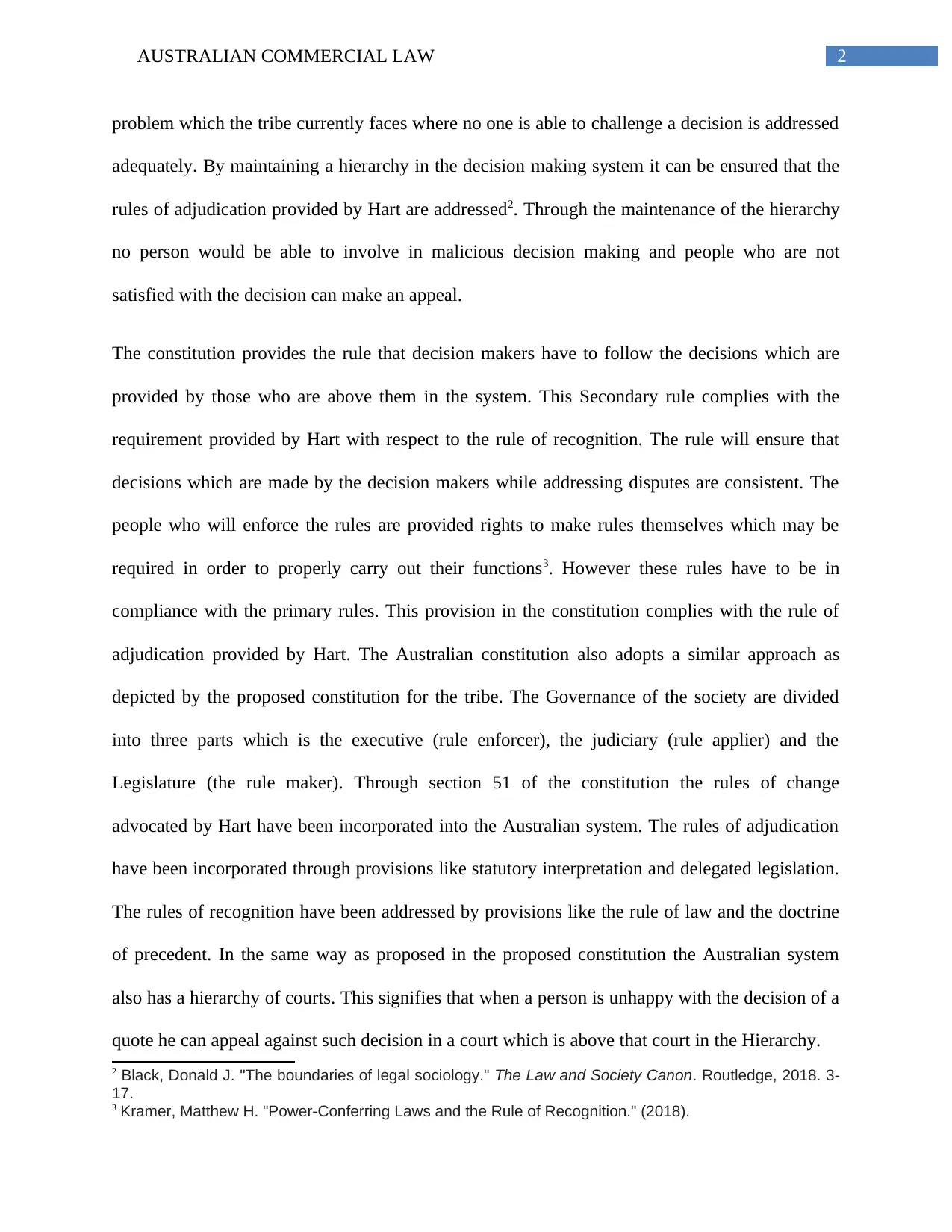
2AUSTRALIAN COMMERCIAL LAW
problem which the tribe currently faces where no one is able to challenge a decision is addressed
adequately. By maintaining a hierarchy in the decision making system it can be ensured that the
rules of adjudication provided by Hart are addressed2. Through the maintenance of the hierarchy
no person would be able to involve in malicious decision making and people who are not
satisfied with the decision can make an appeal.
The constitution provides the rule that decision makers have to follow the decisions which are
provided by those who are above them in the system. This Secondary rule complies with the
requirement provided by Hart with respect to the rule of recognition. The rule will ensure that
decisions which are made by the decision makers while addressing disputes are consistent. The
people who will enforce the rules are provided rights to make rules themselves which may be
required in order to properly carry out their functions3. However these rules have to be in
compliance with the primary rules. This provision in the constitution complies with the rule of
adjudication provided by Hart. The Australian constitution also adopts a similar approach as
depicted by the proposed constitution for the tribe. The Governance of the society are divided
into three parts which is the executive (rule enforcer), the judiciary (rule applier) and the
Legislature (the rule maker). Through section 51 of the constitution the rules of change
advocated by Hart have been incorporated into the Australian system. The rules of adjudication
have been incorporated through provisions like statutory interpretation and delegated legislation.
The rules of recognition have been addressed by provisions like the rule of law and the doctrine
of precedent. In the same way as proposed in the proposed constitution the Australian system
also has a hierarchy of courts. This signifies that when a person is unhappy with the decision of a
quote he can appeal against such decision in a court which is above that court in the Hierarchy.
2 Black, Donald J. "The boundaries of legal sociology." The Law and Society Canon. Routledge, 2018. 3-
17.
3 Kramer, Matthew H. "Power-Conferring Laws and the Rule of Recognition." (2018).
problem which the tribe currently faces where no one is able to challenge a decision is addressed
adequately. By maintaining a hierarchy in the decision making system it can be ensured that the
rules of adjudication provided by Hart are addressed2. Through the maintenance of the hierarchy
no person would be able to involve in malicious decision making and people who are not
satisfied with the decision can make an appeal.
The constitution provides the rule that decision makers have to follow the decisions which are
provided by those who are above them in the system. This Secondary rule complies with the
requirement provided by Hart with respect to the rule of recognition. The rule will ensure that
decisions which are made by the decision makers while addressing disputes are consistent. The
people who will enforce the rules are provided rights to make rules themselves which may be
required in order to properly carry out their functions3. However these rules have to be in
compliance with the primary rules. This provision in the constitution complies with the rule of
adjudication provided by Hart. The Australian constitution also adopts a similar approach as
depicted by the proposed constitution for the tribe. The Governance of the society are divided
into three parts which is the executive (rule enforcer), the judiciary (rule applier) and the
Legislature (the rule maker). Through section 51 of the constitution the rules of change
advocated by Hart have been incorporated into the Australian system. The rules of adjudication
have been incorporated through provisions like statutory interpretation and delegated legislation.
The rules of recognition have been addressed by provisions like the rule of law and the doctrine
of precedent. In the same way as proposed in the proposed constitution the Australian system
also has a hierarchy of courts. This signifies that when a person is unhappy with the decision of a
quote he can appeal against such decision in a court which is above that court in the Hierarchy.
2 Black, Donald J. "The boundaries of legal sociology." The Law and Society Canon. Routledge, 2018. 3-
17.
3 Kramer, Matthew H. "Power-Conferring Laws and the Rule of Recognition." (2018).
⊘ This is a preview!⊘
Do you want full access?
Subscribe today to unlock all pages.

Trusted by 1+ million students worldwide
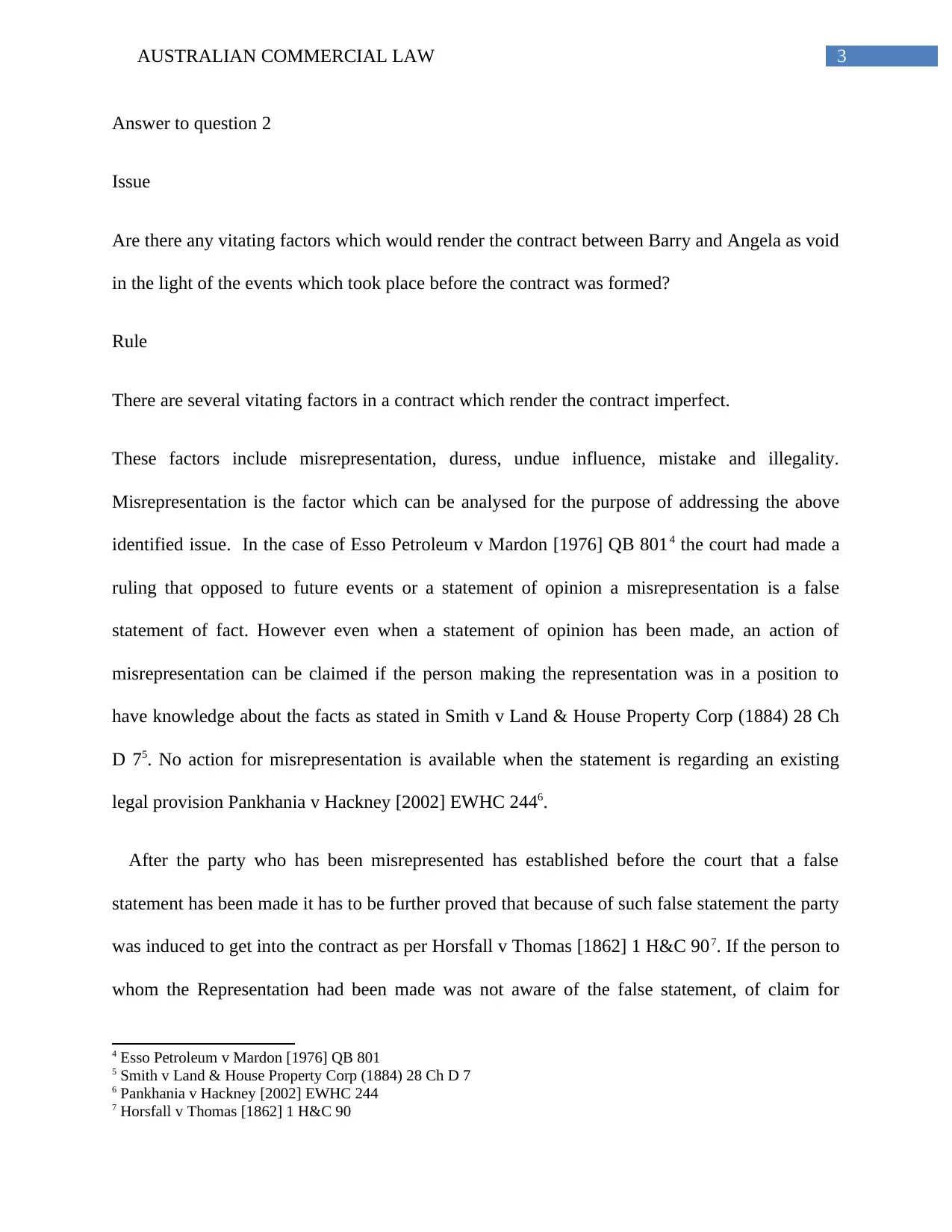
3AUSTRALIAN COMMERCIAL LAW
Answer to question 2
Issue
Are there any vitating factors which would render the contract between Barry and Angela as void
in the light of the events which took place before the contract was formed?
Rule
There are several vitating factors in a contract which render the contract imperfect.
These factors include misrepresentation, duress, undue influence, mistake and illegality.
Misrepresentation is the factor which can be analysed for the purpose of addressing the above
identified issue. In the case of Esso Petroleum v Mardon [1976] QB 8014 the court had made a
ruling that opposed to future events or a statement of opinion a misrepresentation is a false
statement of fact. However even when a statement of opinion has been made, an action of
misrepresentation can be claimed if the person making the representation was in a position to
have knowledge about the facts as stated in Smith v Land & House Property Corp (1884) 28 Ch
D 75. No action for misrepresentation is available when the statement is regarding an existing
legal provision Pankhania v Hackney [2002] EWHC 2446.
After the party who has been misrepresented has established before the court that a false
statement has been made it has to be further proved that because of such false statement the party
was induced to get into the contract as per Horsfall v Thomas [1862] 1 H&C 907. If the person to
whom the Representation had been made was not aware of the false statement, of claim for
4 Esso Petroleum v Mardon [1976] QB 801
5 Smith v Land & House Property Corp (1884) 28 Ch D 7
6 Pankhania v Hackney [2002] EWHC 244
7 Horsfall v Thomas [1862] 1 H&C 90
Answer to question 2
Issue
Are there any vitating factors which would render the contract between Barry and Angela as void
in the light of the events which took place before the contract was formed?
Rule
There are several vitating factors in a contract which render the contract imperfect.
These factors include misrepresentation, duress, undue influence, mistake and illegality.
Misrepresentation is the factor which can be analysed for the purpose of addressing the above
identified issue. In the case of Esso Petroleum v Mardon [1976] QB 8014 the court had made a
ruling that opposed to future events or a statement of opinion a misrepresentation is a false
statement of fact. However even when a statement of opinion has been made, an action of
misrepresentation can be claimed if the person making the representation was in a position to
have knowledge about the facts as stated in Smith v Land & House Property Corp (1884) 28 Ch
D 75. No action for misrepresentation is available when the statement is regarding an existing
legal provision Pankhania v Hackney [2002] EWHC 2446.
After the party who has been misrepresented has established before the court that a false
statement has been made it has to be further proved that because of such false statement the party
was induced to get into the contract as per Horsfall v Thomas [1862] 1 H&C 907. If the person to
whom the Representation had been made was not aware of the false statement, of claim for
4 Esso Petroleum v Mardon [1976] QB 801
5 Smith v Land & House Property Corp (1884) 28 Ch D 7
6 Pankhania v Hackney [2002] EWHC 244
7 Horsfall v Thomas [1862] 1 H&C 90
Paraphrase This Document
Need a fresh take? Get an instant paraphrase of this document with our AI Paraphraser
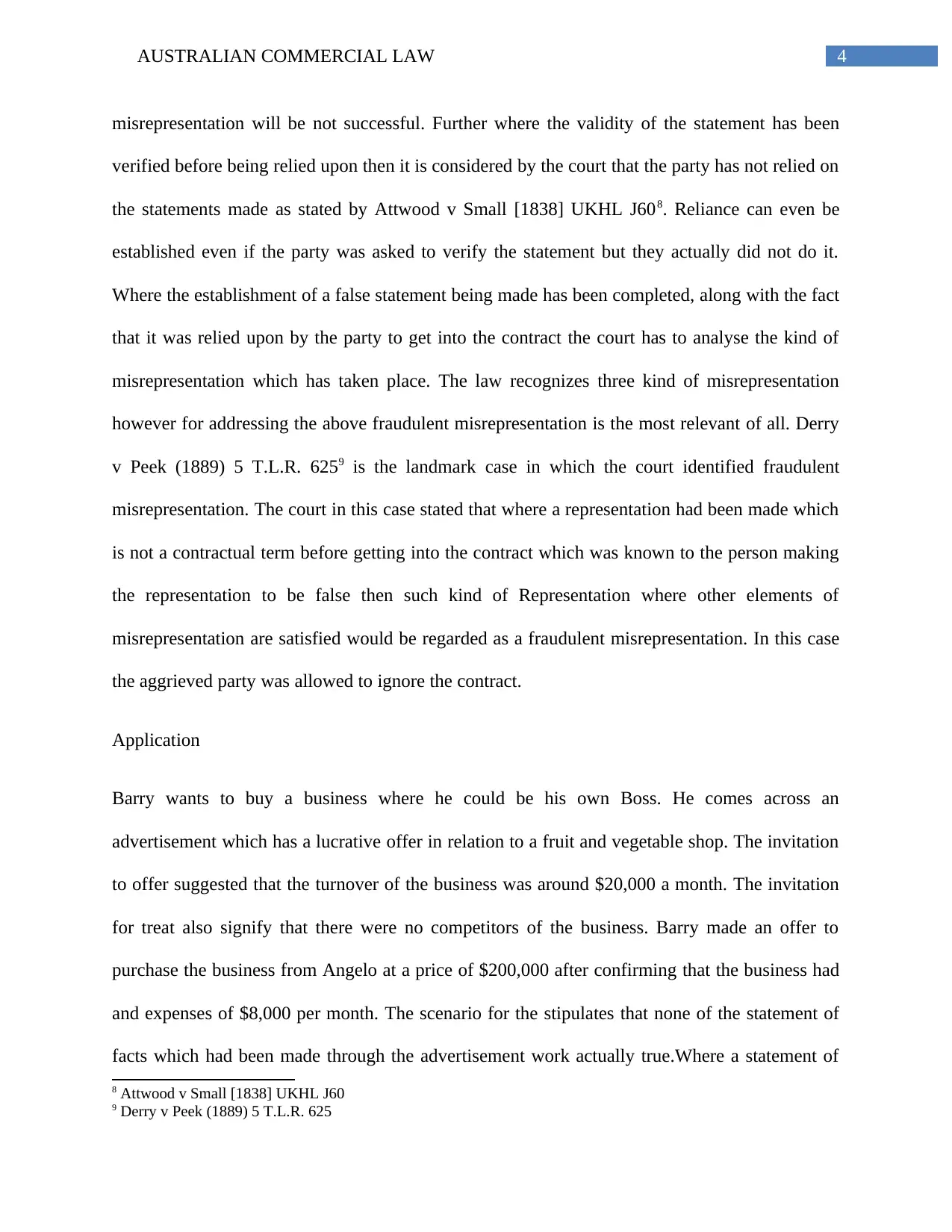
4AUSTRALIAN COMMERCIAL LAW
misrepresentation will be not successful. Further where the validity of the statement has been
verified before being relied upon then it is considered by the court that the party has not relied on
the statements made as stated by Attwood v Small [1838] UKHL J608. Reliance can even be
established even if the party was asked to verify the statement but they actually did not do it.
Where the establishment of a false statement being made has been completed, along with the fact
that it was relied upon by the party to get into the contract the court has to analyse the kind of
misrepresentation which has taken place. The law recognizes three kind of misrepresentation
however for addressing the above fraudulent misrepresentation is the most relevant of all. Derry
v Peek (1889) 5 T.L.R. 6259 is the landmark case in which the court identified fraudulent
misrepresentation. The court in this case stated that where a representation had been made which
is not a contractual term before getting into the contract which was known to the person making
the representation to be false then such kind of Representation where other elements of
misrepresentation are satisfied would be regarded as a fraudulent misrepresentation. In this case
the aggrieved party was allowed to ignore the contract.
Application
Barry wants to buy a business where he could be his own Boss. He comes across an
advertisement which has a lucrative offer in relation to a fruit and vegetable shop. The invitation
to offer suggested that the turnover of the business was around $20,000 a month. The invitation
for treat also signify that there were no competitors of the business. Barry made an offer to
purchase the business from Angelo at a price of $200,000 after confirming that the business had
and expenses of $8,000 per month. The scenario for the stipulates that none of the statement of
facts which had been made through the advertisement work actually true.Where a statement of
8 Attwood v Small [1838] UKHL J60
9 Derry v Peek (1889) 5 T.L.R. 625
misrepresentation will be not successful. Further where the validity of the statement has been
verified before being relied upon then it is considered by the court that the party has not relied on
the statements made as stated by Attwood v Small [1838] UKHL J608. Reliance can even be
established even if the party was asked to verify the statement but they actually did not do it.
Where the establishment of a false statement being made has been completed, along with the fact
that it was relied upon by the party to get into the contract the court has to analyse the kind of
misrepresentation which has taken place. The law recognizes three kind of misrepresentation
however for addressing the above fraudulent misrepresentation is the most relevant of all. Derry
v Peek (1889) 5 T.L.R. 6259 is the landmark case in which the court identified fraudulent
misrepresentation. The court in this case stated that where a representation had been made which
is not a contractual term before getting into the contract which was known to the person making
the representation to be false then such kind of Representation where other elements of
misrepresentation are satisfied would be regarded as a fraudulent misrepresentation. In this case
the aggrieved party was allowed to ignore the contract.
Application
Barry wants to buy a business where he could be his own Boss. He comes across an
advertisement which has a lucrative offer in relation to a fruit and vegetable shop. The invitation
to offer suggested that the turnover of the business was around $20,000 a month. The invitation
for treat also signify that there were no competitors of the business. Barry made an offer to
purchase the business from Angelo at a price of $200,000 after confirming that the business had
and expenses of $8,000 per month. The scenario for the stipulates that none of the statement of
facts which had been made through the advertisement work actually true.Where a statement of
8 Attwood v Small [1838] UKHL J60
9 Derry v Peek (1889) 5 T.L.R. 625
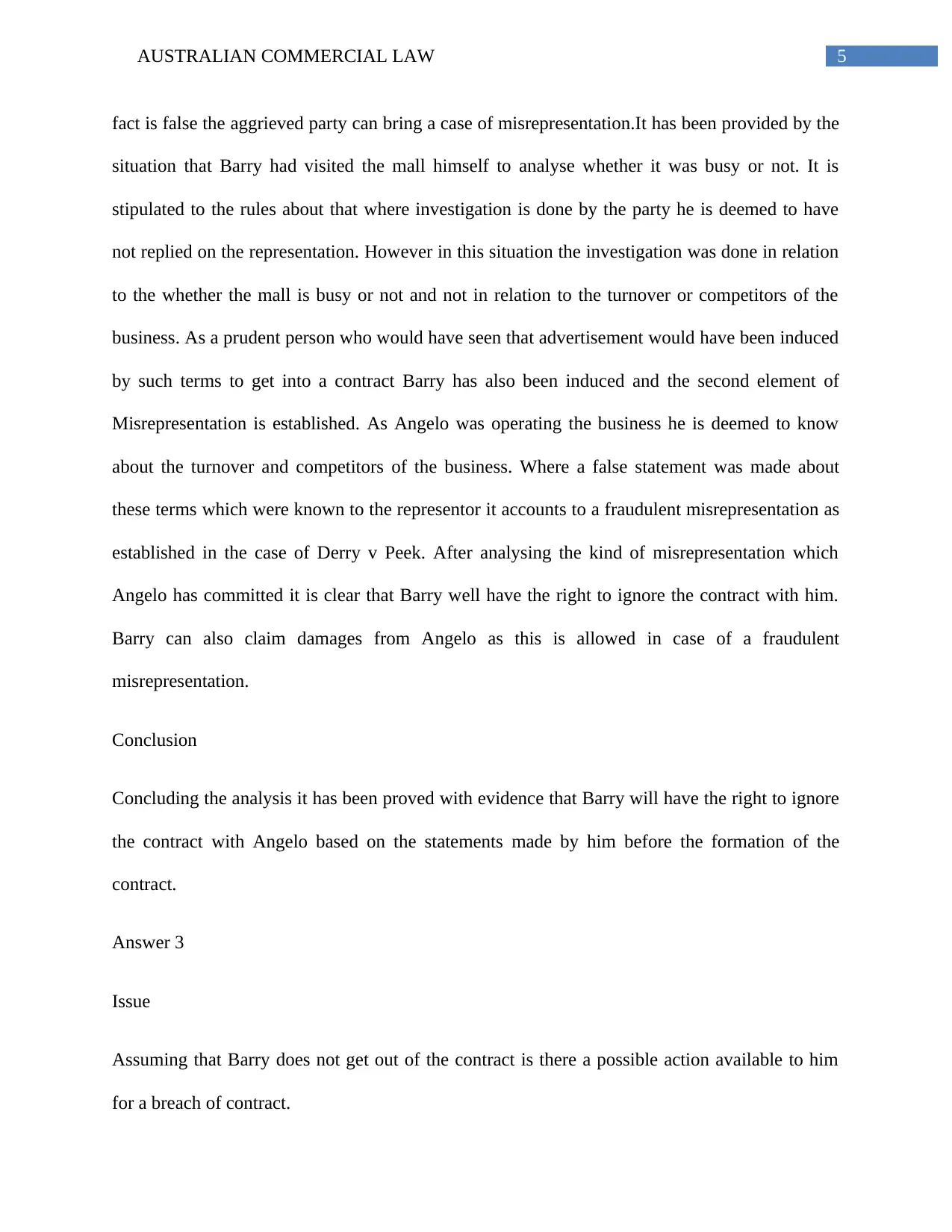
5AUSTRALIAN COMMERCIAL LAW
fact is false the aggrieved party can bring a case of misrepresentation.It has been provided by the
situation that Barry had visited the mall himself to analyse whether it was busy or not. It is
stipulated to the rules about that where investigation is done by the party he is deemed to have
not replied on the representation. However in this situation the investigation was done in relation
to the whether the mall is busy or not and not in relation to the turnover or competitors of the
business. As a prudent person who would have seen that advertisement would have been induced
by such terms to get into a contract Barry has also been induced and the second element of
Misrepresentation is established. As Angelo was operating the business he is deemed to know
about the turnover and competitors of the business. Where a false statement was made about
these terms which were known to the representor it accounts to a fraudulent misrepresentation as
established in the case of Derry v Peek. After analysing the kind of misrepresentation which
Angelo has committed it is clear that Barry well have the right to ignore the contract with him.
Barry can also claim damages from Angelo as this is allowed in case of a fraudulent
misrepresentation.
Conclusion
Concluding the analysis it has been proved with evidence that Barry will have the right to ignore
the contract with Angelo based on the statements made by him before the formation of the
contract.
Answer 3
Issue
Assuming that Barry does not get out of the contract is there a possible action available to him
for a breach of contract.
fact is false the aggrieved party can bring a case of misrepresentation.It has been provided by the
situation that Barry had visited the mall himself to analyse whether it was busy or not. It is
stipulated to the rules about that where investigation is done by the party he is deemed to have
not replied on the representation. However in this situation the investigation was done in relation
to the whether the mall is busy or not and not in relation to the turnover or competitors of the
business. As a prudent person who would have seen that advertisement would have been induced
by such terms to get into a contract Barry has also been induced and the second element of
Misrepresentation is established. As Angelo was operating the business he is deemed to know
about the turnover and competitors of the business. Where a false statement was made about
these terms which were known to the representor it accounts to a fraudulent misrepresentation as
established in the case of Derry v Peek. After analysing the kind of misrepresentation which
Angelo has committed it is clear that Barry well have the right to ignore the contract with him.
Barry can also claim damages from Angelo as this is allowed in case of a fraudulent
misrepresentation.
Conclusion
Concluding the analysis it has been proved with evidence that Barry will have the right to ignore
the contract with Angelo based on the statements made by him before the formation of the
contract.
Answer 3
Issue
Assuming that Barry does not get out of the contract is there a possible action available to him
for a breach of contract.
⊘ This is a preview!⊘
Do you want full access?
Subscribe today to unlock all pages.

Trusted by 1+ million students worldwide
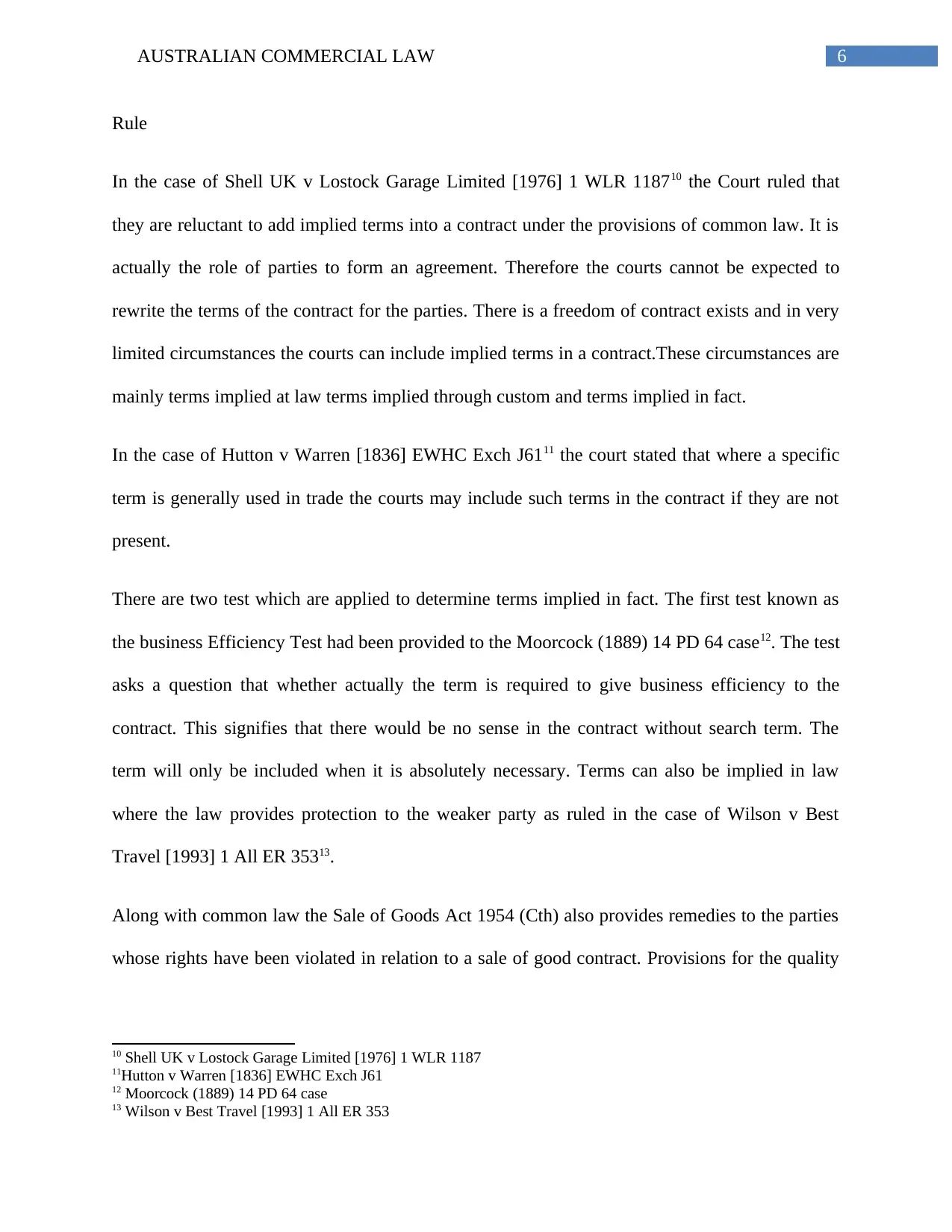
6AUSTRALIAN COMMERCIAL LAW
Rule
In the case of Shell UK v Lostock Garage Limited [1976] 1 WLR 118710 the Court ruled that
they are reluctant to add implied terms into a contract under the provisions of common law. It is
actually the role of parties to form an agreement. Therefore the courts cannot be expected to
rewrite the terms of the contract for the parties. There is a freedom of contract exists and in very
limited circumstances the courts can include implied terms in a contract.These circumstances are
mainly terms implied at law terms implied through custom and terms implied in fact.
In the case of Hutton v Warren [1836] EWHC Exch J6111 the court stated that where a specific
term is generally used in trade the courts may include such terms in the contract if they are not
present.
There are two test which are applied to determine terms implied in fact. The first test known as
the business Efficiency Test had been provided to the Moorcock (1889) 14 PD 64 case12. The test
asks a question that whether actually the term is required to give business efficiency to the
contract. This signifies that there would be no sense in the contract without search term. The
term will only be included when it is absolutely necessary. Terms can also be implied in law
where the law provides protection to the weaker party as ruled in the case of Wilson v Best
Travel [1993] 1 All ER 35313.
Along with common law the Sale of Goods Act 1954 (Cth) also provides remedies to the parties
whose rights have been violated in relation to a sale of good contract. Provisions for the quality
10 Shell UK v Lostock Garage Limited [1976] 1 WLR 1187
11Hutton v Warren [1836] EWHC Exch J61
12 Moorcock (1889) 14 PD 64 case
13 Wilson v Best Travel [1993] 1 All ER 353
Rule
In the case of Shell UK v Lostock Garage Limited [1976] 1 WLR 118710 the Court ruled that
they are reluctant to add implied terms into a contract under the provisions of common law. It is
actually the role of parties to form an agreement. Therefore the courts cannot be expected to
rewrite the terms of the contract for the parties. There is a freedom of contract exists and in very
limited circumstances the courts can include implied terms in a contract.These circumstances are
mainly terms implied at law terms implied through custom and terms implied in fact.
In the case of Hutton v Warren [1836] EWHC Exch J6111 the court stated that where a specific
term is generally used in trade the courts may include such terms in the contract if they are not
present.
There are two test which are applied to determine terms implied in fact. The first test known as
the business Efficiency Test had been provided to the Moorcock (1889) 14 PD 64 case12. The test
asks a question that whether actually the term is required to give business efficiency to the
contract. This signifies that there would be no sense in the contract without search term. The
term will only be included when it is absolutely necessary. Terms can also be implied in law
where the law provides protection to the weaker party as ruled in the case of Wilson v Best
Travel [1993] 1 All ER 35313.
Along with common law the Sale of Goods Act 1954 (Cth) also provides remedies to the parties
whose rights have been violated in relation to a sale of good contract. Provisions for the quality
10 Shell UK v Lostock Garage Limited [1976] 1 WLR 1187
11Hutton v Warren [1836] EWHC Exch J61
12 Moorcock (1889) 14 PD 64 case
13 Wilson v Best Travel [1993] 1 All ER 353
Paraphrase This Document
Need a fresh take? Get an instant paraphrase of this document with our AI Paraphraser
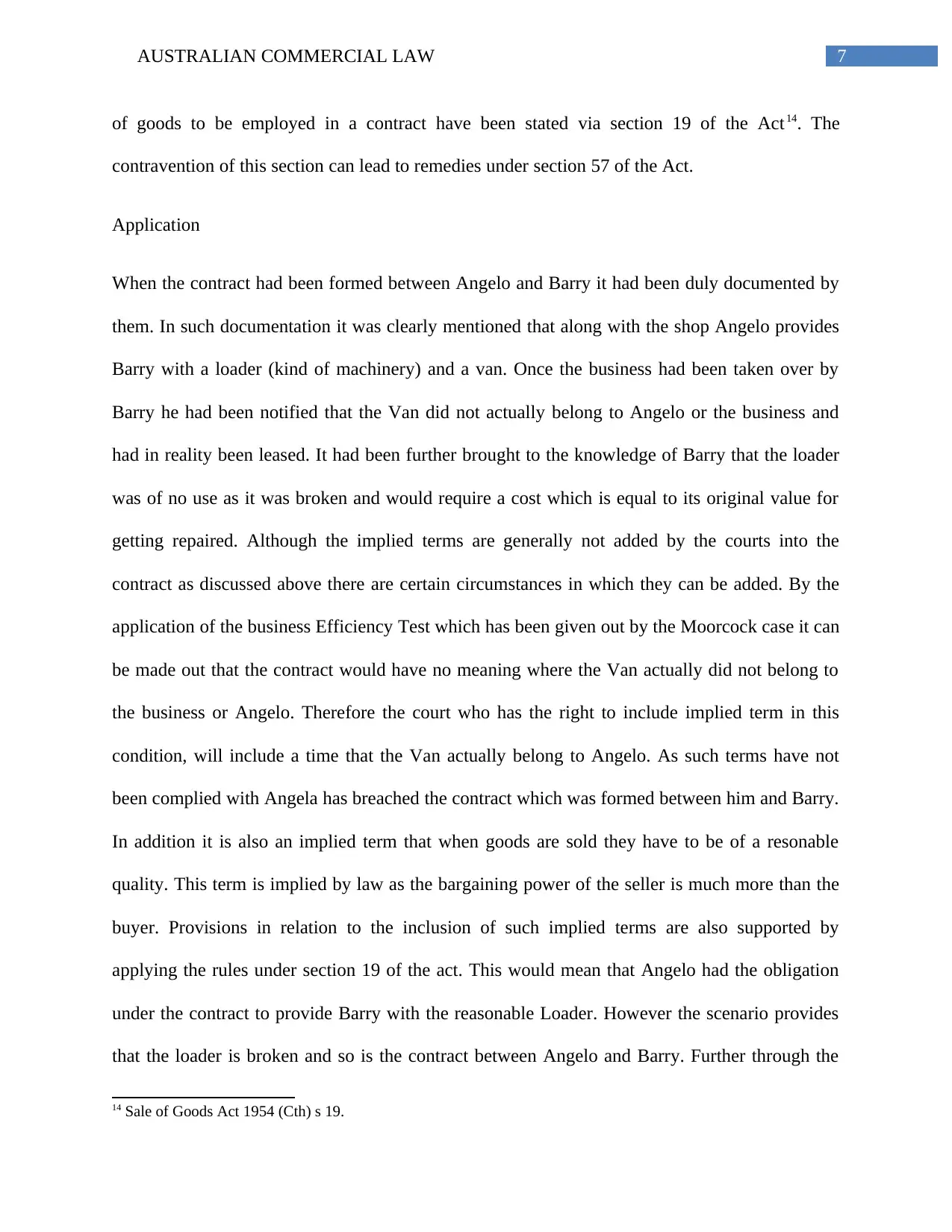
7AUSTRALIAN COMMERCIAL LAW
of goods to be employed in a contract have been stated via section 19 of the Act14. The
contravention of this section can lead to remedies under section 57 of the Act.
Application
When the contract had been formed between Angelo and Barry it had been duly documented by
them. In such documentation it was clearly mentioned that along with the shop Angelo provides
Barry with a loader (kind of machinery) and a van. Once the business had been taken over by
Barry he had been notified that the Van did not actually belong to Angelo or the business and
had in reality been leased. It had been further brought to the knowledge of Barry that the loader
was of no use as it was broken and would require a cost which is equal to its original value for
getting repaired. Although the implied terms are generally not added by the courts into the
contract as discussed above there are certain circumstances in which they can be added. By the
application of the business Efficiency Test which has been given out by the Moorcock case it can
be made out that the contract would have no meaning where the Van actually did not belong to
the business or Angelo. Therefore the court who has the right to include implied term in this
condition, will include a time that the Van actually belong to Angelo. As such terms have not
been complied with Angela has breached the contract which was formed between him and Barry.
In addition it is also an implied term that when goods are sold they have to be of a resonable
quality. This term is implied by law as the bargaining power of the seller is much more than the
buyer. Provisions in relation to the inclusion of such implied terms are also supported by
applying the rules under section 19 of the act. This would mean that Angelo had the obligation
under the contract to provide Barry with the reasonable Loader. However the scenario provides
that the loader is broken and so is the contract between Angelo and Barry. Further through the
14 Sale of Goods Act 1954 (Cth) s 19.
of goods to be employed in a contract have been stated via section 19 of the Act14. The
contravention of this section can lead to remedies under section 57 of the Act.
Application
When the contract had been formed between Angelo and Barry it had been duly documented by
them. In such documentation it was clearly mentioned that along with the shop Angelo provides
Barry with a loader (kind of machinery) and a van. Once the business had been taken over by
Barry he had been notified that the Van did not actually belong to Angelo or the business and
had in reality been leased. It had been further brought to the knowledge of Barry that the loader
was of no use as it was broken and would require a cost which is equal to its original value for
getting repaired. Although the implied terms are generally not added by the courts into the
contract as discussed above there are certain circumstances in which they can be added. By the
application of the business Efficiency Test which has been given out by the Moorcock case it can
be made out that the contract would have no meaning where the Van actually did not belong to
the business or Angelo. Therefore the court who has the right to include implied term in this
condition, will include a time that the Van actually belong to Angelo. As such terms have not
been complied with Angela has breached the contract which was formed between him and Barry.
In addition it is also an implied term that when goods are sold they have to be of a resonable
quality. This term is implied by law as the bargaining power of the seller is much more than the
buyer. Provisions in relation to the inclusion of such implied terms are also supported by
applying the rules under section 19 of the act. This would mean that Angelo had the obligation
under the contract to provide Barry with the reasonable Loader. However the scenario provides
that the loader is broken and so is the contract between Angelo and Barry. Further through the
14 Sale of Goods Act 1954 (Cth) s 19.
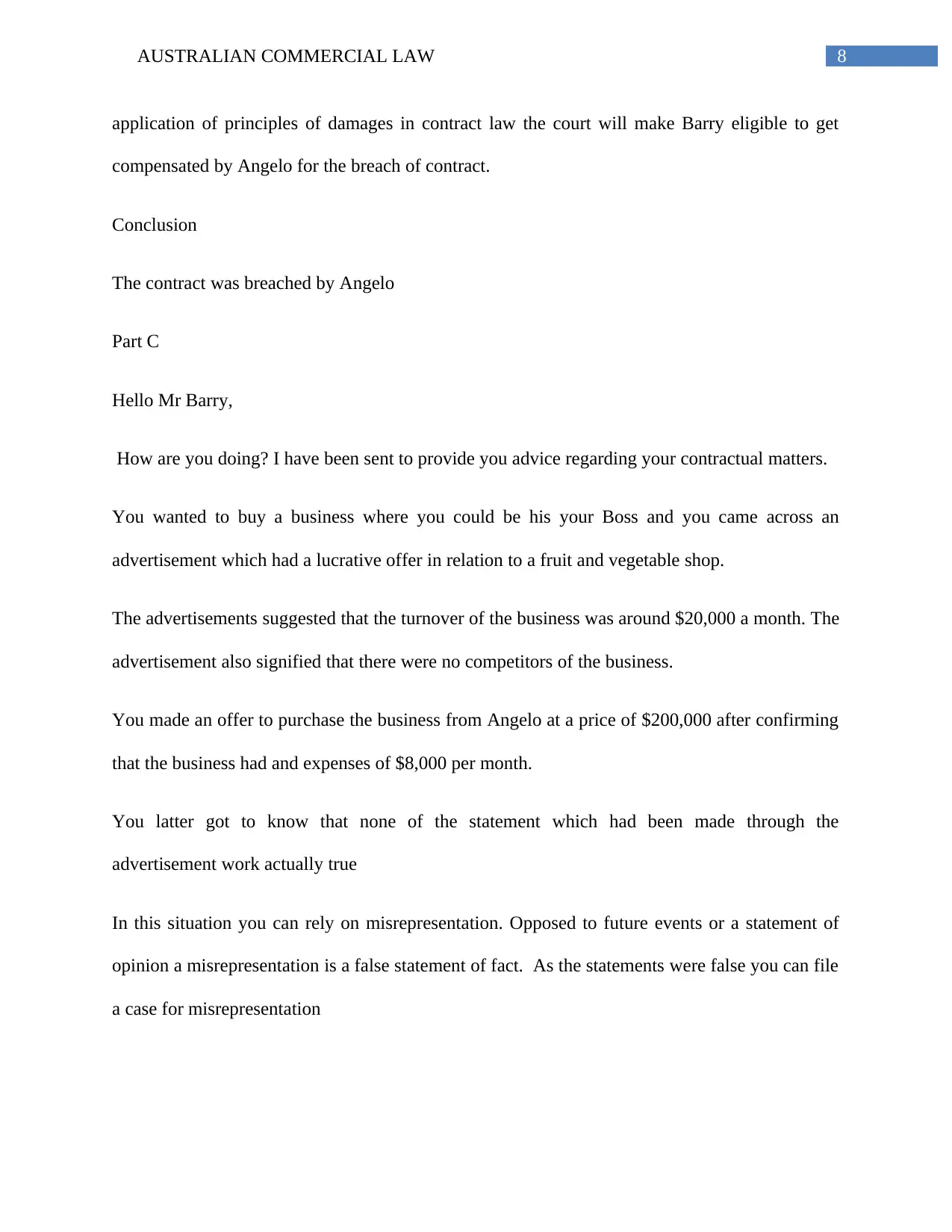
8AUSTRALIAN COMMERCIAL LAW
application of principles of damages in contract law the court will make Barry eligible to get
compensated by Angelo for the breach of contract.
Conclusion
The contract was breached by Angelo
Part C
Hello Mr Barry,
How are you doing? I have been sent to provide you advice regarding your contractual matters.
You wanted to buy a business where you could be his your Boss and you came across an
advertisement which had a lucrative offer in relation to a fruit and vegetable shop.
The advertisements suggested that the turnover of the business was around $20,000 a month. The
advertisement also signified that there were no competitors of the business.
You made an offer to purchase the business from Angelo at a price of $200,000 after confirming
that the business had and expenses of $8,000 per month.
You latter got to know that none of the statement which had been made through the
advertisement work actually true
In this situation you can rely on misrepresentation. Opposed to future events or a statement of
opinion a misrepresentation is a false statement of fact. As the statements were false you can file
a case for misrepresentation
application of principles of damages in contract law the court will make Barry eligible to get
compensated by Angelo for the breach of contract.
Conclusion
The contract was breached by Angelo
Part C
Hello Mr Barry,
How are you doing? I have been sent to provide you advice regarding your contractual matters.
You wanted to buy a business where you could be his your Boss and you came across an
advertisement which had a lucrative offer in relation to a fruit and vegetable shop.
The advertisements suggested that the turnover of the business was around $20,000 a month. The
advertisement also signified that there were no competitors of the business.
You made an offer to purchase the business from Angelo at a price of $200,000 after confirming
that the business had and expenses of $8,000 per month.
You latter got to know that none of the statement which had been made through the
advertisement work actually true
In this situation you can rely on misrepresentation. Opposed to future events or a statement of
opinion a misrepresentation is a false statement of fact. As the statements were false you can file
a case for misrepresentation
⊘ This is a preview!⊘
Do you want full access?
Subscribe today to unlock all pages.

Trusted by 1+ million students worldwide
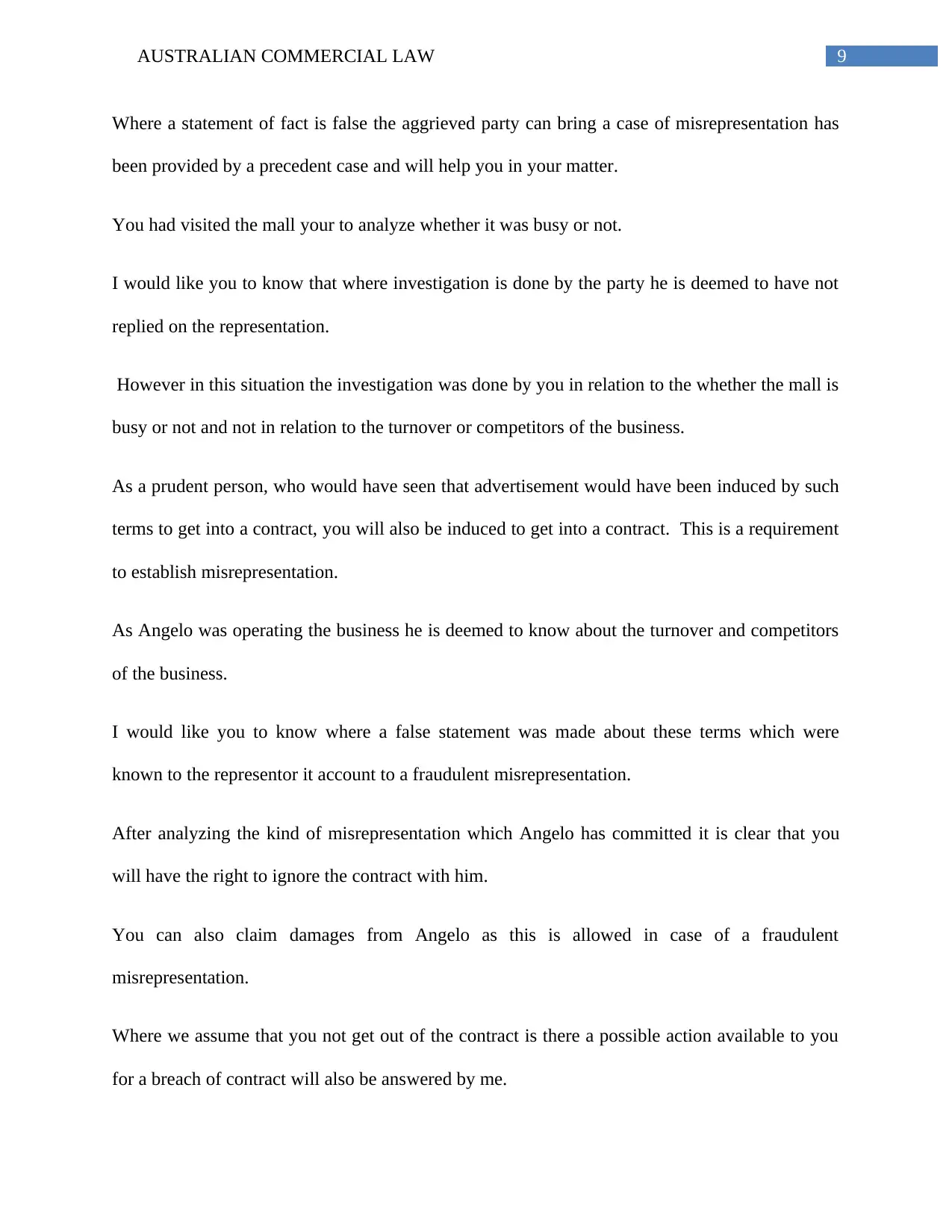
9AUSTRALIAN COMMERCIAL LAW
Where a statement of fact is false the aggrieved party can bring a case of misrepresentation has
been provided by a precedent case and will help you in your matter.
You had visited the mall your to analyze whether it was busy or not.
I would like you to know that where investigation is done by the party he is deemed to have not
replied on the representation.
However in this situation the investigation was done by you in relation to the whether the mall is
busy or not and not in relation to the turnover or competitors of the business.
As a prudent person, who would have seen that advertisement would have been induced by such
terms to get into a contract, you will also be induced to get into a contract. This is a requirement
to establish misrepresentation.
As Angelo was operating the business he is deemed to know about the turnover and competitors
of the business.
I would like you to know where a false statement was made about these terms which were
known to the representor it account to a fraudulent misrepresentation.
After analyzing the kind of misrepresentation which Angelo has committed it is clear that you
will have the right to ignore the contract with him.
You can also claim damages from Angelo as this is allowed in case of a fraudulent
misrepresentation.
Where we assume that you not get out of the contract is there a possible action available to you
for a breach of contract will also be answered by me.
Where a statement of fact is false the aggrieved party can bring a case of misrepresentation has
been provided by a precedent case and will help you in your matter.
You had visited the mall your to analyze whether it was busy or not.
I would like you to know that where investigation is done by the party he is deemed to have not
replied on the representation.
However in this situation the investigation was done by you in relation to the whether the mall is
busy or not and not in relation to the turnover or competitors of the business.
As a prudent person, who would have seen that advertisement would have been induced by such
terms to get into a contract, you will also be induced to get into a contract. This is a requirement
to establish misrepresentation.
As Angelo was operating the business he is deemed to know about the turnover and competitors
of the business.
I would like you to know where a false statement was made about these terms which were
known to the representor it account to a fraudulent misrepresentation.
After analyzing the kind of misrepresentation which Angelo has committed it is clear that you
will have the right to ignore the contract with him.
You can also claim damages from Angelo as this is allowed in case of a fraudulent
misrepresentation.
Where we assume that you not get out of the contract is there a possible action available to you
for a breach of contract will also be answered by me.
Paraphrase This Document
Need a fresh take? Get an instant paraphrase of this document with our AI Paraphraser
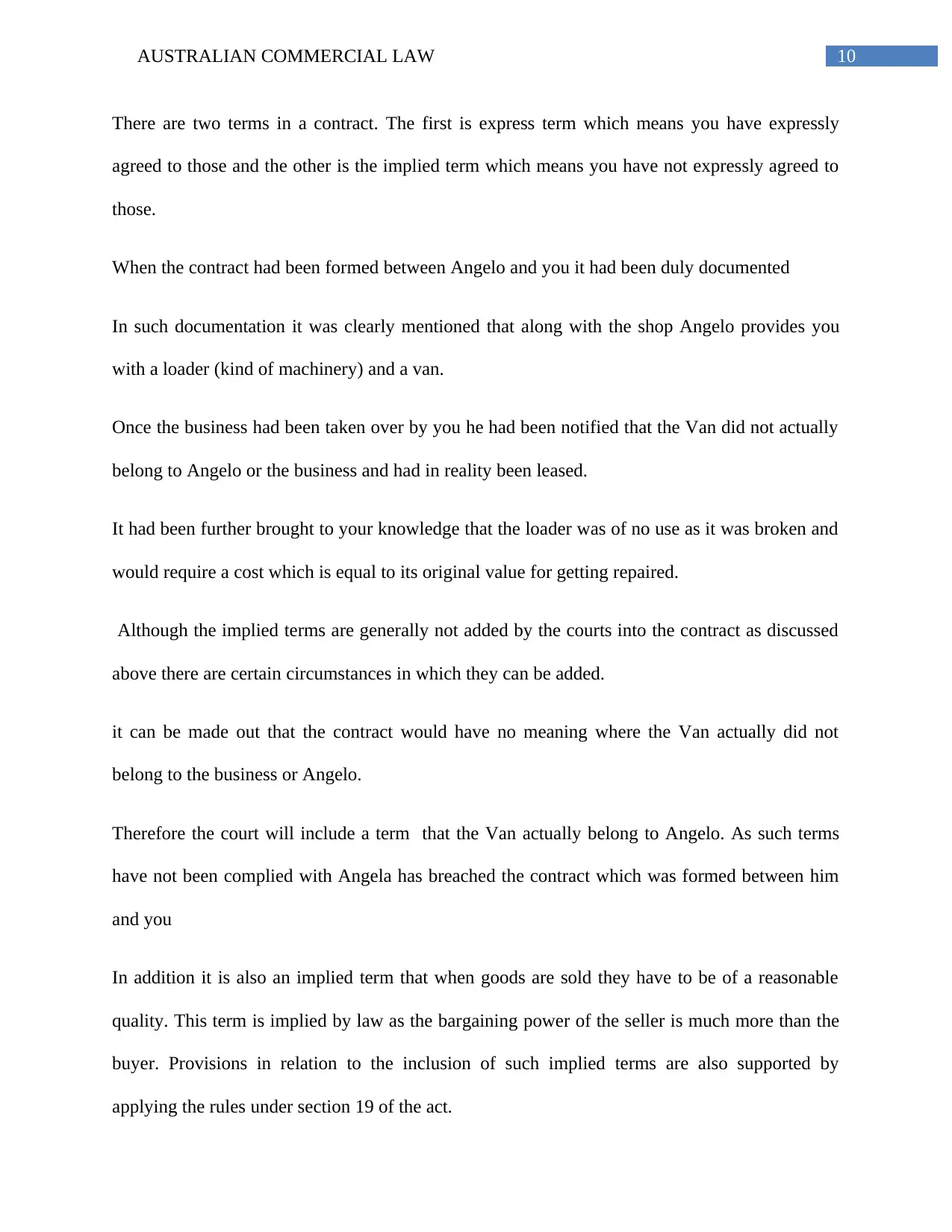
10AUSTRALIAN COMMERCIAL LAW
There are two terms in a contract. The first is express term which means you have expressly
agreed to those and the other is the implied term which means you have not expressly agreed to
those.
When the contract had been formed between Angelo and you it had been duly documented
In such documentation it was clearly mentioned that along with the shop Angelo provides you
with a loader (kind of machinery) and a van.
Once the business had been taken over by you he had been notified that the Van did not actually
belong to Angelo or the business and had in reality been leased.
It had been further brought to your knowledge that the loader was of no use as it was broken and
would require a cost which is equal to its original value for getting repaired.
Although the implied terms are generally not added by the courts into the contract as discussed
above there are certain circumstances in which they can be added.
it can be made out that the contract would have no meaning where the Van actually did not
belong to the business or Angelo.
Therefore the court will include a term that the Van actually belong to Angelo. As such terms
have not been complied with Angela has breached the contract which was formed between him
and you
In addition it is also an implied term that when goods are sold they have to be of a reasonable
quality. This term is implied by law as the bargaining power of the seller is much more than the
buyer. Provisions in relation to the inclusion of such implied terms are also supported by
applying the rules under section 19 of the act.
There are two terms in a contract. The first is express term which means you have expressly
agreed to those and the other is the implied term which means you have not expressly agreed to
those.
When the contract had been formed between Angelo and you it had been duly documented
In such documentation it was clearly mentioned that along with the shop Angelo provides you
with a loader (kind of machinery) and a van.
Once the business had been taken over by you he had been notified that the Van did not actually
belong to Angelo or the business and had in reality been leased.
It had been further brought to your knowledge that the loader was of no use as it was broken and
would require a cost which is equal to its original value for getting repaired.
Although the implied terms are generally not added by the courts into the contract as discussed
above there are certain circumstances in which they can be added.
it can be made out that the contract would have no meaning where the Van actually did not
belong to the business or Angelo.
Therefore the court will include a term that the Van actually belong to Angelo. As such terms
have not been complied with Angela has breached the contract which was formed between him
and you
In addition it is also an implied term that when goods are sold they have to be of a reasonable
quality. This term is implied by law as the bargaining power of the seller is much more than the
buyer. Provisions in relation to the inclusion of such implied terms are also supported by
applying the rules under section 19 of the act.
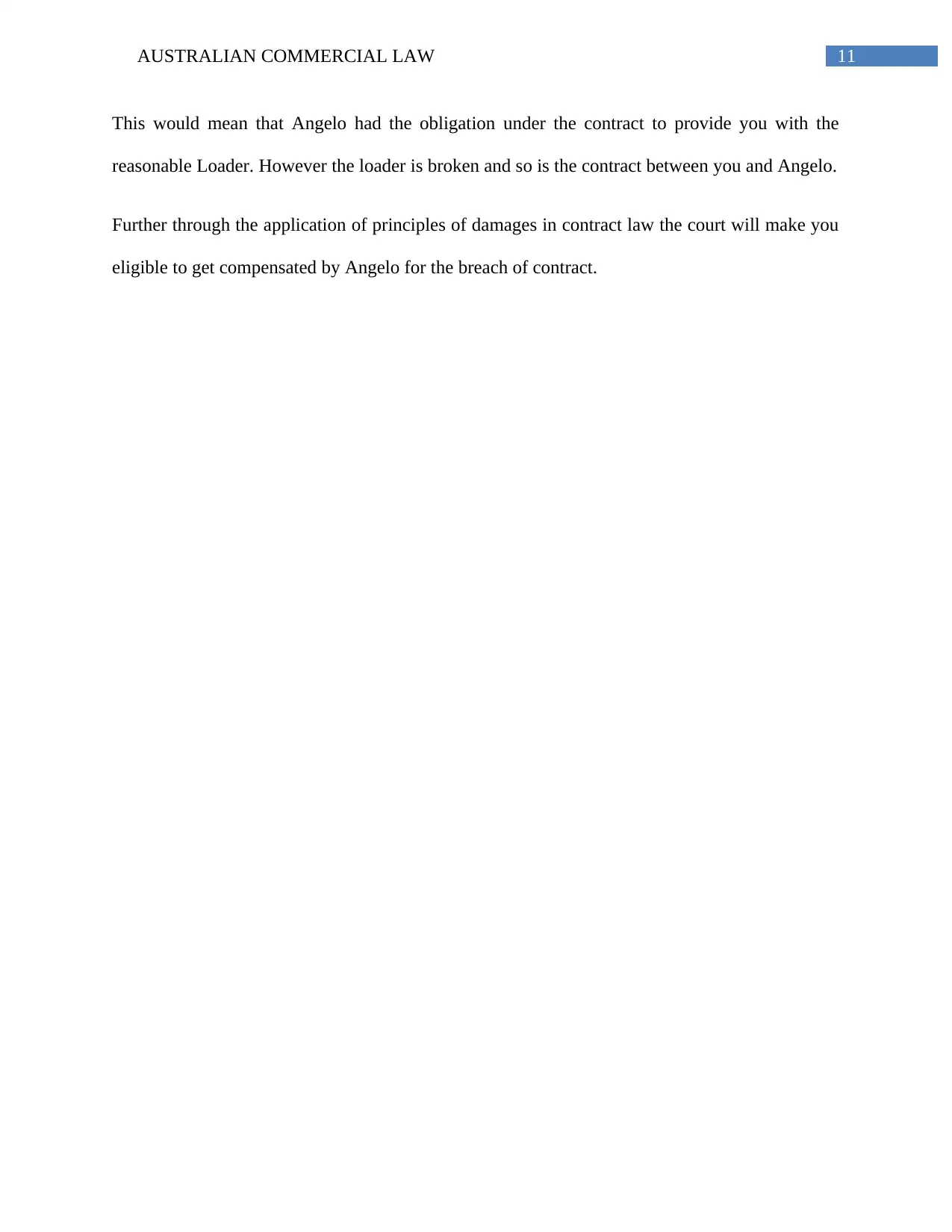
11AUSTRALIAN COMMERCIAL LAW
This would mean that Angelo had the obligation under the contract to provide you with the
reasonable Loader. However the loader is broken and so is the contract between you and Angelo.
Further through the application of principles of damages in contract law the court will make you
eligible to get compensated by Angelo for the breach of contract.
This would mean that Angelo had the obligation under the contract to provide you with the
reasonable Loader. However the loader is broken and so is the contract between you and Angelo.
Further through the application of principles of damages in contract law the court will make you
eligible to get compensated by Angelo for the breach of contract.
⊘ This is a preview!⊘
Do you want full access?
Subscribe today to unlock all pages.

Trusted by 1+ million students worldwide
1 out of 13
Related Documents
Your All-in-One AI-Powered Toolkit for Academic Success.
+13062052269
info@desklib.com
Available 24*7 on WhatsApp / Email
![[object Object]](/_next/static/media/star-bottom.7253800d.svg)
Unlock your academic potential
Copyright © 2020–2025 A2Z Services. All Rights Reserved. Developed and managed by ZUCOL.





